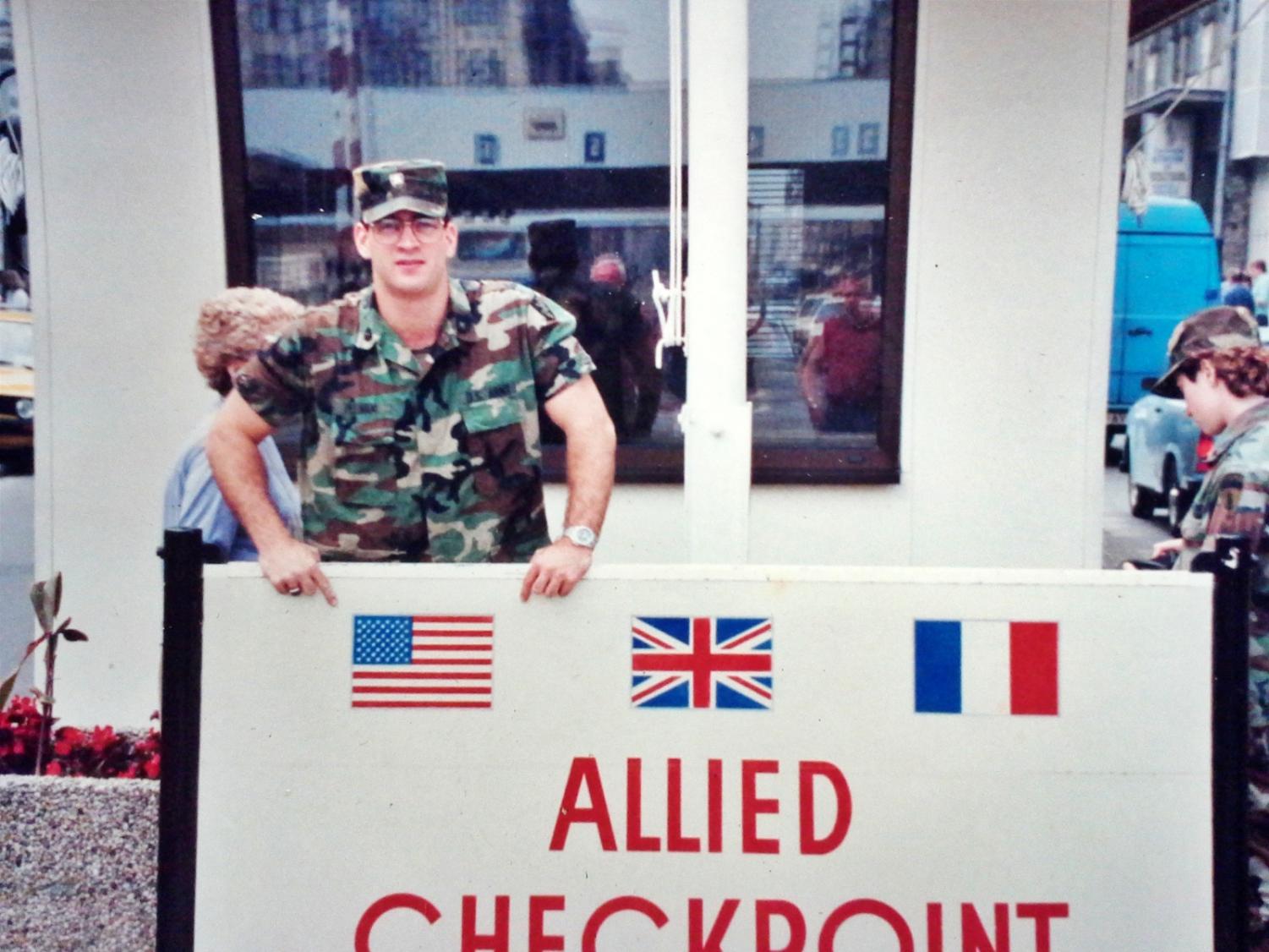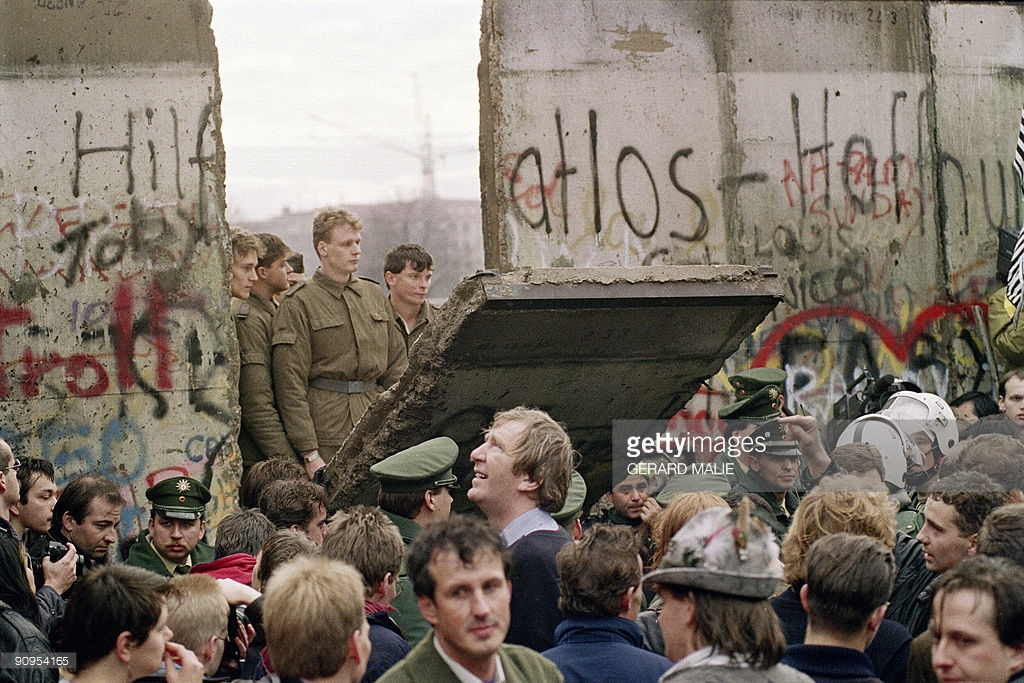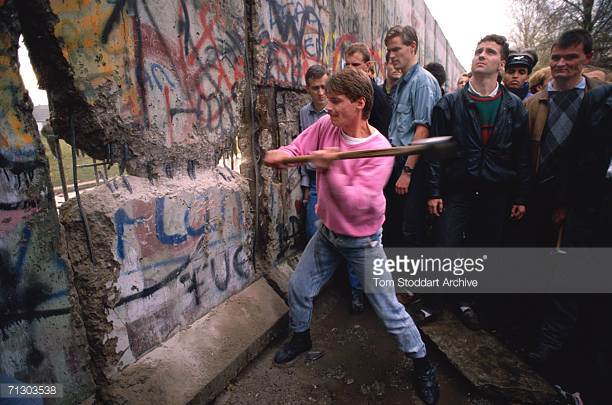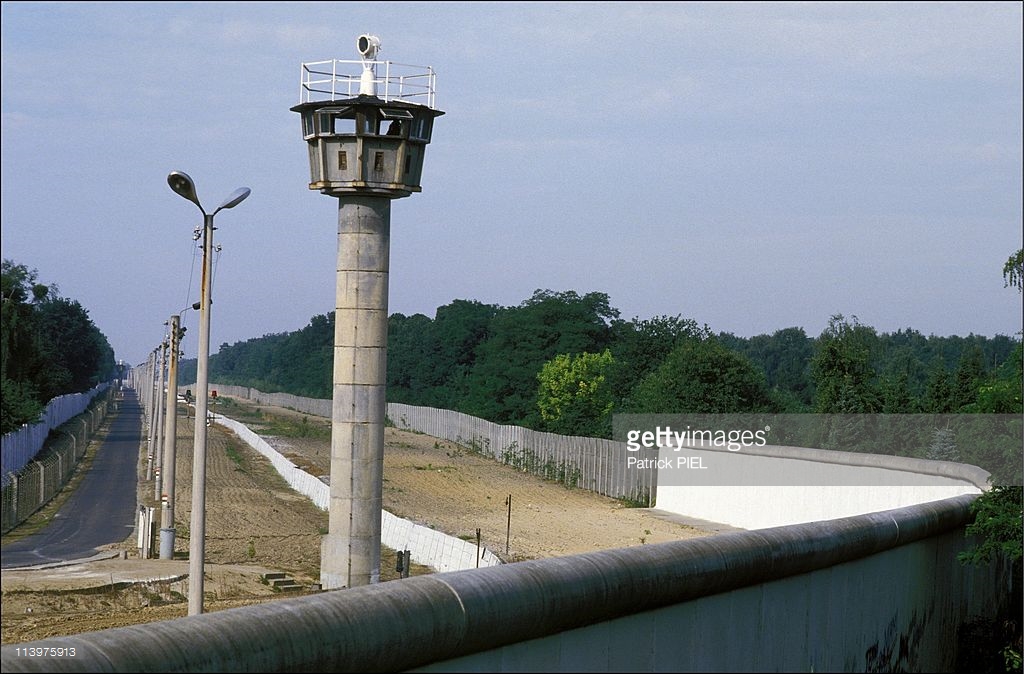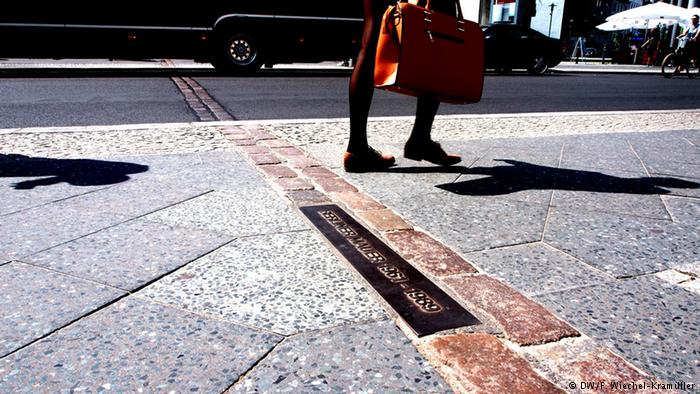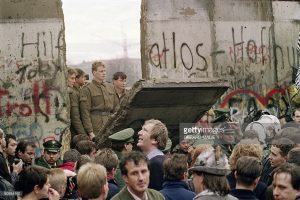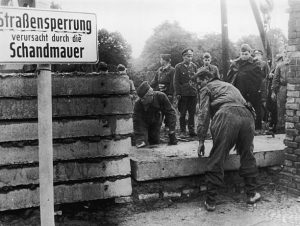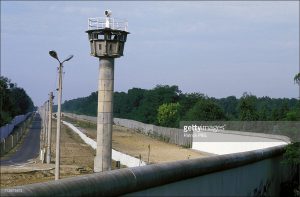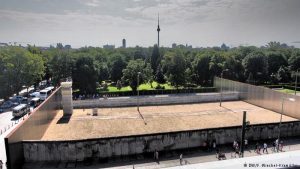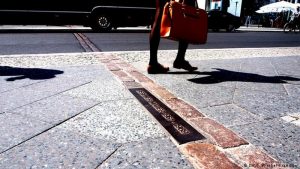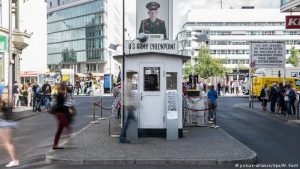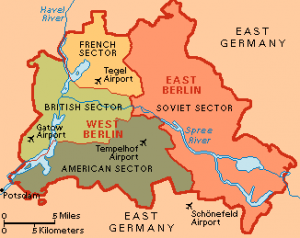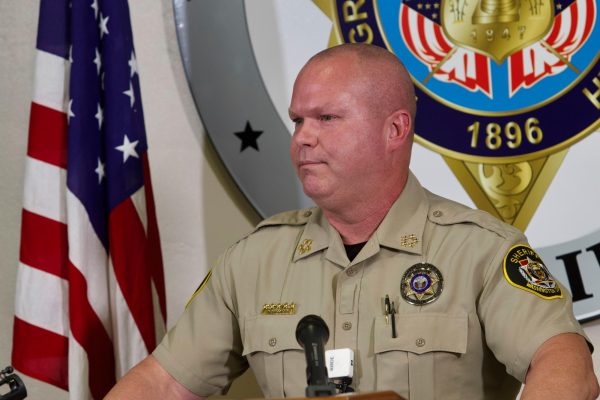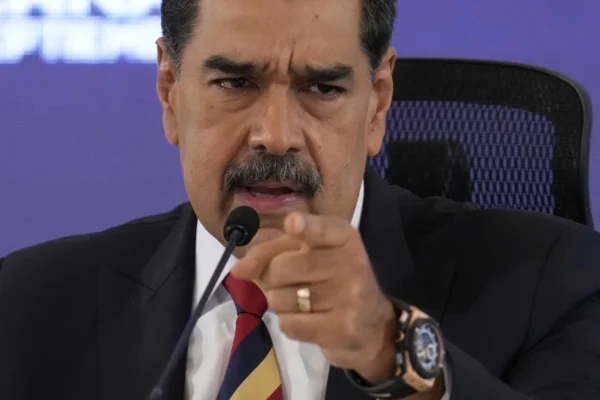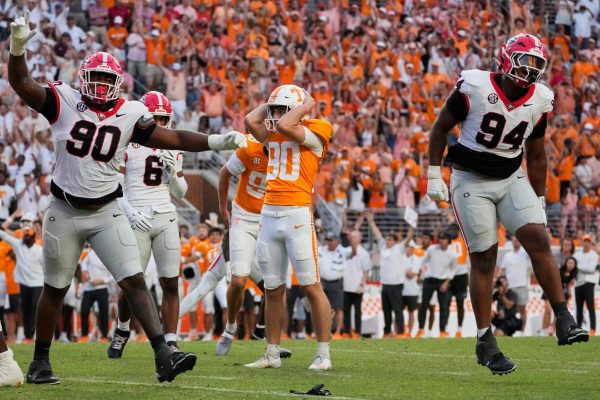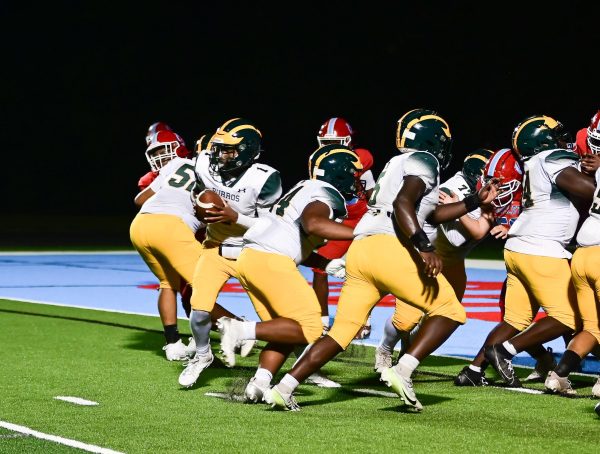“….And the the wall came tumbling down”
“It brought us all hope.” – Dr. Shuler Pelham, a witness to the fall of the Berlin Wall.
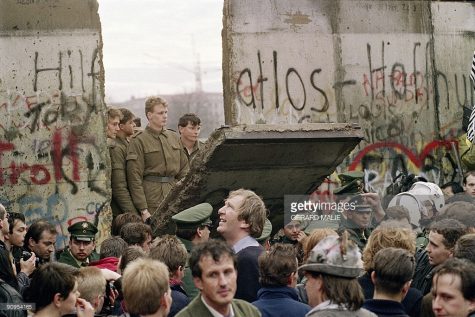
West Berliners crowd in front of the Berlin Wall early 11 November 1989 as they watch East German border guards demolishing a section of the wall in order to open a new crossing point between East and West Berlin, near the Potsdamer Square. AFP PHOTO / GERARD MALIE (Photo credit should read GERARD MALIE/AFP/Getty Images)
In 1989, our very own Hillsboro High School Executive Principal, Dr. Shuler Pelham, was a participant in the dismantling of the Berlin Wall in Berlin, Germany. Dr. Pelham, was a member of the Army Military Intelligence unit at the time he was stationed in Germany and witnessed bullied East Berliners who little by little came first to creep cautiously over the Wall and then eagerly cross the barriers that once stood as a symbolic reminder of the Cold War.
Dr. Pelham was one of 4 West Point Cadets of The Berlin Brigade which was one of the most elite units in all of the U.S. Armed Forces for 50 years.
Imagine for a moment, overnight, a huge concrete wall is erected down the middle of Hillsboro road. This wall is too tall to climb and is topped with razor wire and guards with guns are at every street corner blocking families and friends from traveling from the east side of our school zone to the west.
A crossing point exists at the light that connects the front of the school with the Green Hills Mall and anyone who lives east of the school would have to cross at this checkpoint to visit or shop with anyone west of the school. Imagine that this wall extends all the way to downtown dividing areas of the school zone making anyone you love who lives “on the other side” of the wall off-limits. You would no longer be able to visit with your friends, see family or shop as you have for decades.
Almost overnight “on the night of August 12, 1961, as East Germany began to seal off all points of entrance into West Berlin by stringing barbed wire and posting sentries” states the History Channel.
It was an ugly moment in history.
According to the ‘August 13 Association’ which specializes in the history of the Berlin Wall, at least 938 people – 255 in Berlin alone – died, shot by East German border guards, attempting to flee to West Berlin or West Germany.
Many Americans who are old enough to remember, watched this history being made on their sole television. Gathering around the one television in the living room was common in the 6o’s to watch the news.

1961: Soldiers building the Berlin Wall as instructed by the East German authorities, in order to strengthen the existing barriers dividing East and West Berlin. (Photo by Keystone/Getty Images)
When the wall finally was torn down in 1989, there were parties held in homes to watch CNN cover the Berlin Wall come tumbling down, live on what was a newly formed 24-hour news source. While others get the privilege of experiencing history through watching it on tv, our very own Dr. Pelham is one of those who had the privilege of being able to experience firsthand one of the 20th century’s most important moments in history – the taking down of the Berlin Wall.
When asked what he thought about the Berlin Wall when he saw it for the first time, and what it may have symbolically stood to represent like the Cold War, his response was remarkable.
” I was 21 years old at the time (1990). My entire life had been during the Cold War, and the Berlin Wall was older than me. I can remember thinking that it was just a part of how the world was and that it was hard to believe that it was coming down and changing. It was a physical symbol of the Cold War, and so it coming down reflected a victory of sorts.
Like all Americans who grew up with the Cold War as a presence, the idea that it was “us” or “them” seemed to be illustrated in the way the Wall divided the country of Germany. Dr. Pelham shares his thoughts on his impression of a divided country.
“When I saw how it had simply gone up overnight and had split neighborhoods and families in two, I had a lot of remorse. Clearly, the families who happened to have been on the west side of the
Wall had fared better over time. One culture was split and two different cultures had evolved over the next several decades. No one really knew how they would be rejoined.”
The History behind the Wall
On the West side of Berlin, the West Berliner residents represented a democratic, free society. West Germans lived a better life; they had a good economy, good politics, and freedoms similar to our own country. Life was prosperous compared to the other side of “Checkpoint Charley.
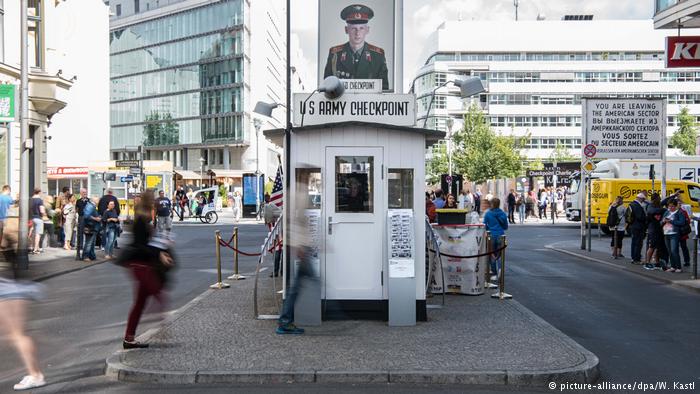
This border crossing is among the best-known sights in Berlin. Only foreigners and diplomats were allowed to pass through this checkpoint. In October 1961, shortly after the Wall was built, there was a standoff here as armed Soviet and American tanks stood face-to-face. The situation very nearly escalated.
However, on the East side of Berlin, life was very different. Their economy was failing and there was poverty. Communism was the political system and the Soviet bloc was failing. Homelessness was very common in East Germany. The Cold War, a war without weapons between mostly the US and Russia would develop into a major political issue. Thus the Berlin Wall came to symbolize the Cold War.
The Eastern side of the wall was completely different from the West. The Berlin Wall came to represent more than concrete and barbed wire, it came to represent Americans. On the Eastside, there was a constant watch on the wall. There were guards, vicious dogs, barbed wire, and tripwire with machine guns. Guards were ordered to shoot on sight if anyone attempted to escape to the West. The West side of the wall was beautiful; it was painted with vibrant colors and murals.
Imagine again Nolensville road – one wall dividing Nashville, different rights, different rules, and the threat of death to one side if those living in the East if don’t follow the rules.
One of the most famous crossing points between West Berlin and East Berlin was Check Point Charley. Dr. Pelham walked through Checkpoint Charlie. He was in Germany for 6 weeks during the time the Berlin Wall was being torn down.
During his time there, change was constant. Germany was beginning to unify and the currency had been switched to West currency for all of Germany. Dr. Pelham was in the Army which is why he was in Germany. He stayed on the West side of the Berlin Wall. However, there were a few times he got to go over to East Germany with special permission from the authorities.
West Germans were allowed to pass through to East Germany, but East Germans could not pass through to West Germany. There were a few exceptions states Dr. Rainer Hildebrand from the Mauer Museum “for East Germans to pass into West Germany such as being elderly pensioners (started 1965), visiting immediate family members for important matters, and professional reasons. Even though there were exceptions, each visit had to be applied for, and approval was never guaranteed.”
East Germans regularly tried to defect to West Germany. From 1961-1989 over 5,000 East Germans crossed the border with unconventional methods such as hot air balloons, jumping out of windows close to the wall, crawling through sewers, and speeding through unfortified parts of the wall. In order to pass through, you had to go through a checkpoint.
Dr. Pelham explained Checkpoint Charlie, as being very small. “So small in fact, that when the wall was torn down, Checkpoint Charlie was picked up with a crane and shipped to the Smithsonian.”
“It was smaller than my office. You could fit Checkpoint Charlie in my office. It’s a little booth with two gates on it.” Dr. Pelham explains.
When explaining the differences between East and West Berlin Dr. Pelham stated that East currency was nothing compared to West currency.
“They would bring anything they could from their homes to sell in makeshift flea markets to get cash to buy goods in West Berlin (such as blue jeans or electronic devices) that they could take back to the East and sell these items that were simply not available in East Berlin. This was not a big surprise—we had hosted some exchange cadets from the USSR the previous spring at West Point. We took them to a local grocery store and they thought that it was all staged—they couldn’t believe that there was that much food in one place at one time and people were not lined up to buy it!” said Dr. Pelham
Learning of this activity, it was interesting to learn that Dr. Pelham did not know any of the families that were actually separated by the wall because he worked in a Military Intelligence unit.
“Because I was working in a Military Intelligence unit while I was there I was very limited on contact with locals. I did have the opportunity to meet a person who had twice tried to escape from the East to the West. His first time he was caught, the second time he was shot in the back, then dragged back to the East by soldiers and imprisoned.
“I remember him mentioning that he wanted to come to the United States and live in Arizona where it was warm. He asked if we had any restrictions about moving around in the United States—could a person choose to live in Arizona. That conversation was 23 years ago and I remember it like it was last week. He also thought all Americans were cowboys, either rode horses or lived in great big mansions. All of his impression of Americans had come from limited reruns of old western movies and Soviet propaganda. I also had a chance to meet families living in the East who would get day passes to come to the West to visit family who were in West Berlin.
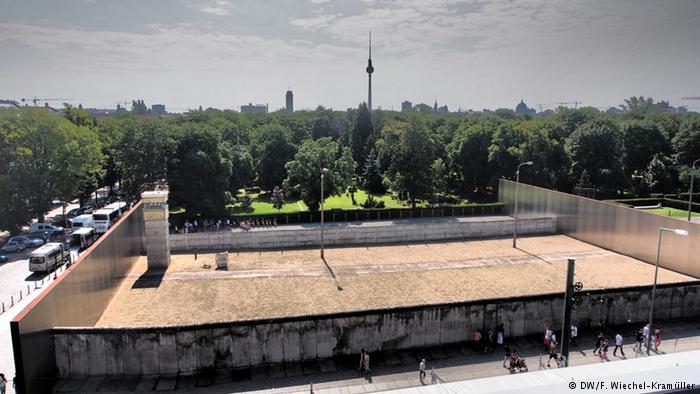
Nowhere is the former “death strip” as vivid as it is here. An 80-meter-long segment of the Wall, including a guard tower, has been reconstructed. The authentic border fortification complex serves as a central monument to the division of Germany. It pays homage to the victims who died or were killed at the Berlin Wall.
Understanding You Are in the Middle of History Being Made
Dr. Pelham piece of the Wall was chiseled with a hammer. Still to this day, he has pieces of the wall in his office. The wall was not broken down all at once. But once the citizens realized it was just a wall and they were allowed to pass freely Dr. Pelham said it was an interesting moment to witness.
Our discussion led to knowing if one understands that history is being made at the moment you are living it. How aware is someone that a monumental moment is taking place? Dr. Pelham shared that like many others his first memories are of “watching this on CNN in one my classes at West Point” where he graduated. ” I can remember watching the people getting more and more aggressive climbing up on the wall and thinking that the soldiers would start shooting them at any minute—this had happened before.”
But like those who watched the Wall tumble and have shared along with Dr. Pelham, when the soldiers did not shoot the East Berliners crossover, “when it didn’t happen, people had hope.”
A few last thoughts on being a participant in such an important moment of history led Dr. Pelham to share that like many of us, in the moment we don’t know change is happening but “eventually people figured out that a change was happening, but didn’t quite know what or where it was going. This was late fall of 1989.”
” By the time I found out I would be one of only 4 West Point cadets traveling to Berlin for my summer internship, I knew I would be there at a historic time. The unit I was in was the remnants of Gen. Patton’s Army that rolled into Berlin in 1945 to occupy at the end of the war. All of the buildings we used were former Nazi buildings (the American Headquarters was the former Luftwaffe Office, my office was in the former Hitler Youth Center).
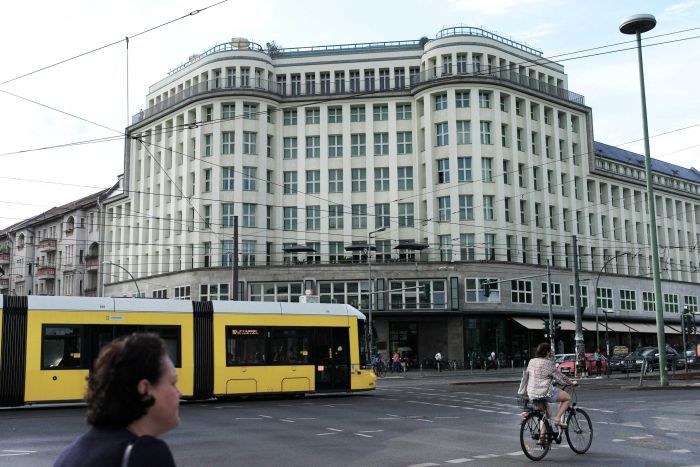

There was a bit of a sense of surrealism to the time there. I had read about and seen pictures of so many places, but it was different to see it in context. The Berlin Brigade had been one of the most elite units in all of the U.S. Armed Forces for 50 years. Their mission was coming to an end with the fall of the USSR and the reunification of East and West Germany, but it was inspiring to be part of this historic place and time.
What we know from history class is the Cold War was about to end.
The second time he went through Checkpoint Charlie, things were different. They were different because at this time the wall was just there. East and West Germany had begun to unify.
Dr. Pelham goes on to share what he witnessed.
“By that point, nobody was checking anything. After they took Checkpoint Charlie out, there were some soldiers over here sitting on some milk crates playing cards, and people started to kind of walk out a little bit then they would stop and the soldiers would see them then go back to playing cards, then they would go a little further. When they saw they weren’t going to do anything, it just became a flood of people coming back and forth. It was a really phenomenal moment.”
November 9, 1989, was the official fall of the Berlin Wall. Over two million people went to the Berlin Wall to help tear it down. They came ready with hammers and all other sorts of tools to break down the Wall such as bulldozers and cranes. For two days it was a party in the streets of Berlin. The East German citizens received gifts from West Germans when they entered over to West Germany.
In Dr. Pelham’s office, he has a framed piece of the Berlin wall and other artifacts from his stay in Germany.

